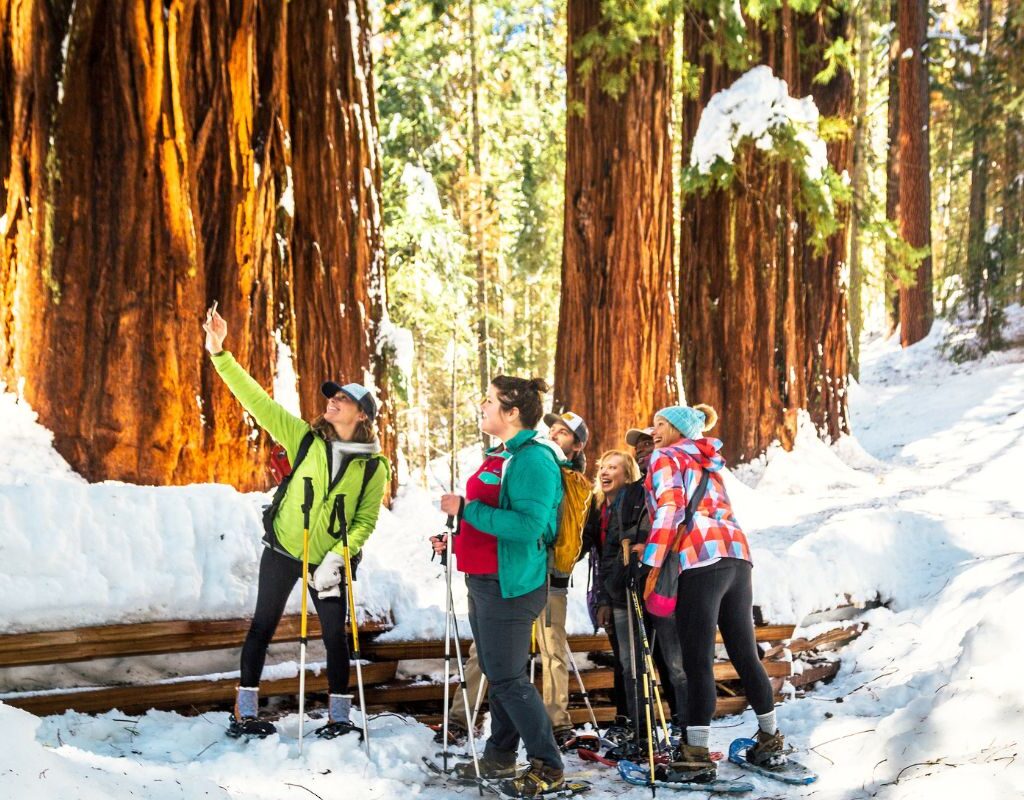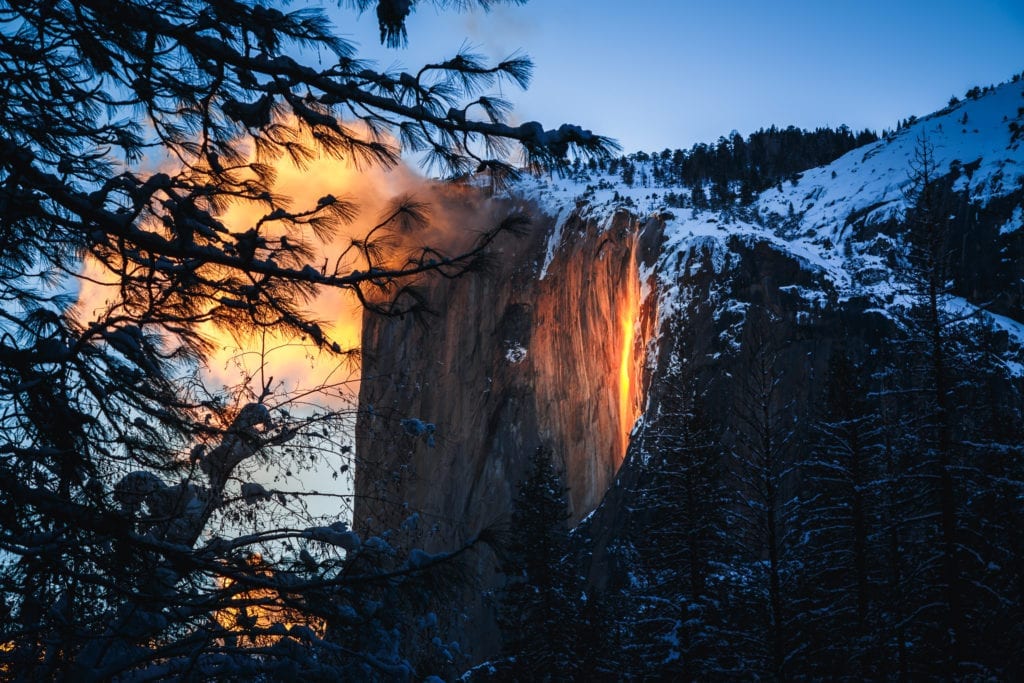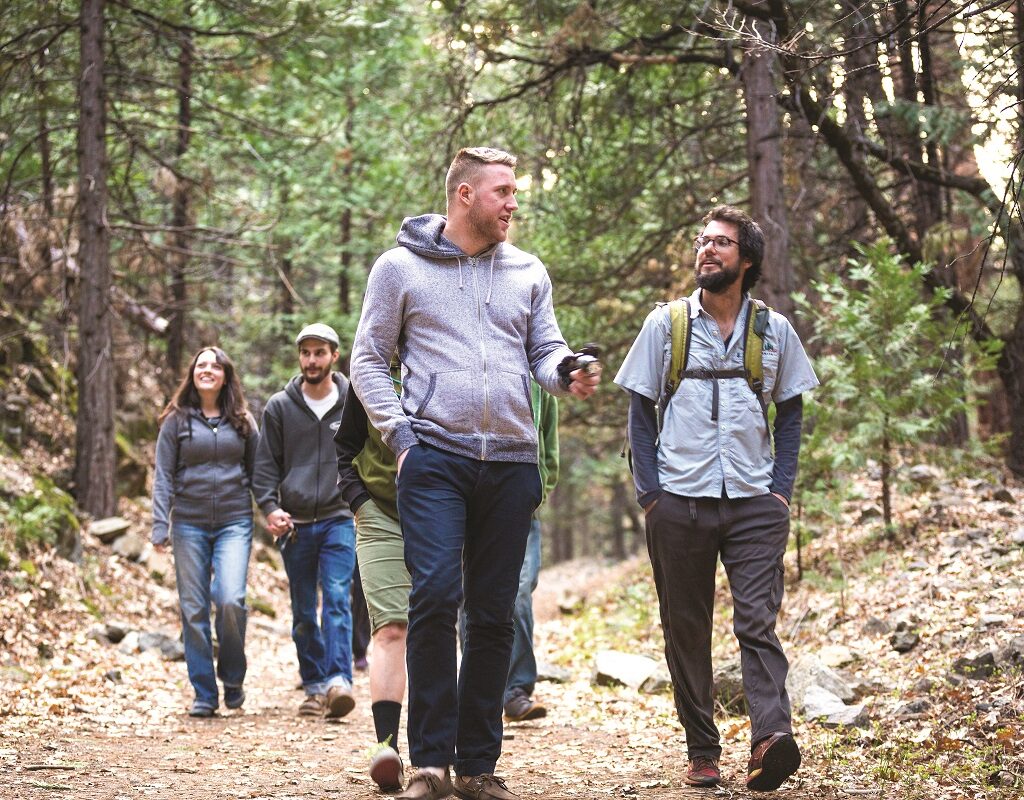In our opinion, the best time of year to visit Yosemite is either late May or early September, when there are fewer crowds, moderate temperatures, and plenty of natural beauty on display.
Late May means limited access to the park, but this is the best time of year to see waterfalls at their peak. In early September, most of the waterfalls in Yosemite Valley are dry or barely trickling, but you’ll have complete access to the park. However, because Yosemite has such a wide array of temperatures throughout the year, we believe Yosemite offers its guests unique beauty to be discovered every season.
Note that weather conditions and park access will be the two biggest factors to consider as you plan what time of year you’d like to take your Yosemite vacation. To assist you, we’ve highlighted the pros and cons of each season in Yosemite. Once you’ve decided when you want to visit, check our special offers to see if we have seasonal deals for you in Evergreen Lodge or Rush Creek Lodge, our cozy lodges near Yosemite National Park.
Winter in Yosemite: The Best Time of Year To Avoid Crowds
November — March
 Smaller crowds are one of the best perks of visiting Yosemite in the winter months. During the winter, average temperatures (°F) range from the mid-40s to the low 20s. For those who love winter sports, this is the best time of year to visit Yosemite.
Smaller crowds are one of the best perks of visiting Yosemite in the winter months. During the winter, average temperatures (°F) range from the mid-40s to the low 20s. For those who love winter sports, this is the best time of year to visit Yosemite.
Visitors can participate in tubing, snowshoeing, and skiing (downhill and cross country) at the Badger Pass Ski Area found on Glacier Point Road. Our Yosemite lodges have gas fireplaces in select cabins on our Evergreen Lodge property, and you can book a Rush Creek suite or villa with a cozy cast iron gas fireplace, as well, so you’ll stay warm even as the snow falls.
 Beyond snow sports and fewer crowds, winter is the only time of year guests can see the Horsetail Fall Firefall, a unique phenomenon in Yosemite Valley. This natural beauty is normally visible during the last two weeks of February at the Horsetail Fall located on the eastern edge of El Capitan. On clear evenings as the sun is setting, the light reflects on the waterfall causing it to glow with vibrant oranges and yellows that look like fire. Check out NPS.com for more details.
Beyond snow sports and fewer crowds, winter is the only time of year guests can see the Horsetail Fall Firefall, a unique phenomenon in Yosemite Valley. This natural beauty is normally visible during the last two weeks of February at the Horsetail Fall located on the eastern edge of El Capitan. On clear evenings as the sun is setting, the light reflects on the waterfall causing it to glow with vibrant oranges and yellows that look like fire. Check out NPS.com for more details.
Another winter-only event in Yosemite is the annual Bracebridge Dinner, where park visitors have the chance “to party like it’s 1899!” This event has been a legendary part of Yosemite’s history since the 1920s, surprisingly inspired by renowned landscape photographer Ansel Adams as director. The Bracebridge Dinner transports patrons to 18th-century England for a Christmas pageant and multi-course dinner. The Ahwahnee Dining Room transforms into a majestic manor hall thanks to elaborate decorations and exquisitely costumed singers, members of the San Francisco Opera, who fill the room with beautiful music.
Yosemite National Park has several Free Entrance Days throughout the year where guests are welcomed into the park at no charge. Note that these dates change annually. During the winter, enjoy free park entry on Martin Luther King Jr.’s birthday and Veterans Day. Our Rush Creek Lodge Holiday Gift Guide offers fantastic suggestions for Yosemite-style activities to delight friends and family who love being in the great outdoors during the winter months.
The challenge of the winter months in Yosemite is temporary road closures. With 75% of the total precipitation for the year (most of which falls in the form of snow) occurring between these months, some roads become inaccessible to plows and other vehicles. Tioga, Glacier Point (beyond the Ski Area), and Mariposa Grove Roads are closed due to snow during the winter. This also means the eastern entrance of the park is inaccessible. Snow chains are required in many areas of the park that remain open.
Spring in Yosemite: The Best Time of Year To See Waterfalls
April — May
 Wildflowers, waterfalls, and whitewater rafting are the major pros of springtime in Yosemite. In April the average temperatures (°F) range from the mid-50s to the mid-30s. Moving into May, the averages range from the 60s to the mid-30s. As the world around here thaws, wildflowers and dogwood trees find their way into bloom.
Wildflowers, waterfalls, and whitewater rafting are the major pros of springtime in Yosemite. In April the average temperatures (°F) range from the mid-50s to the mid-30s. Moving into May, the averages range from the 60s to the mid-30s. As the world around here thaws, wildflowers and dogwood trees find their way into bloom.
Snow melt causes waterfalls throughout the park to begin flowing and gushing to their fullest. This increased water flow kicks off the season for whitewater rafting in Yosemite. Spring is a wonderful time to snap photos for our annual Wildflowers and Waterfalls Contest, when both make spectacular displays as they wake up from winter.
Even though the snow stops falling around March in Yosemite, the plowing process normally isn’t completed for a couple of months. There’s a local saying that “winter isn’t officially over until snowfall has dusted the dogwoods.” Access to the Mariposa Grove typically reopens in April. Tioga and Glacier Point Roads reopen between late May and early June most years.
 Trail hiking becomes accessible during spring starting in lower elevations like Yosemite Valley and Hetch Hetchy. As the temperatures warm, snow and ice melt and more trails become passable. Depending on the amount of sun the trail gets during the day, some patches may still have snow and ice on them, so watch your step.
Trail hiking becomes accessible during spring starting in lower elevations like Yosemite Valley and Hetch Hetchy. As the temperatures warm, snow and ice melt and more trails become passable. Depending on the amount of sun the trail gets during the day, some patches may still have snow and ice on them, so watch your step.
Special Days & Events during spring include Earth Day. NPS hosts events across the country at each of the national parks, educating visitors about nature, safety, and protecting the parks while offering fun with music, tours, and more. During the spring, enjoy free park entry on the first day of National Park Week.
Early May also brings the annual Yosemite Half Marathon. This event sells out quickly so participants are encouraged to reserve their spot early. If you’re planning on running in the half marathon, we recommend booking your stay and your spa appointment at Rush Creek Lodge Spa or Evergreen Lodge for a relaxing recovery after the race.
The downer of springtime in Yosemite is the continued limited access within the park. Skiing and other winter sports end in April. The amount of snow from the previous winter determines when seasonal roads reopen. During these months, high elevation hiking isn’t recommended without proper hiking equipment and experience.
Summer in Yosemite: The Best Time of Year For Camping
June — August
 Summer in Yosemite brings with it complete access to the park. This time of year, all roads will be accessible. Temperatures (°F) average in the 80s during the day and 40s during the night. Depending on your elevation, you can see daytime temperatures reach the 70s in the mountains or the 90s in the valleys.
Summer in Yosemite brings with it complete access to the park. This time of year, all roads will be accessible. Temperatures (°F) average in the 80s during the day and 40s during the night. Depending on your elevation, you can see daytime temperatures reach the 70s in the mountains or the 90s in the valleys.
Summer is the best time of year for camping in Yosemite. All of the campgrounds are open and there is very little precipitation during these months. Comfortable evening temperatures make it wonderful for stargazing and exploration of the park to find Moonbows, rainbows formed by the light of a full moon. We offer custom Yosemite camping at Evergreen Lodge, and families staying at Rush Creek Lodge in summer can enjoy afternoons hiking our property trails.

With these warmer temperatures, summer is also the only time of year for snow-free high alpine hiking. For those looking to climb Half Dome or hike the High Sierras, summer is your season. Please note that permits are required for most high alpine hiking and backpacking trips.
We recommend visiting Tuolumne Meadows off of Tioga Road during these months. The elevation is about 4000 feet higher than the ever-popular Yosemite Valley, which makes for much cooler temperatures. The Meadows are also filled with beautiful wildflowers during the summer months.
If you visit during the summer months, you’ll have the chance to participate in the annual Apple Picking Day, which happens sometime in July or August, depending on when the fruit ripens. Culling the fruit removes this tasty temptation from bear paws, helping alleviate human-bear conflicts and keeping both animals safer. The park invites guests to help harvest the historic apple orchards in Yosemite Valley; email the park’s Volunteer Office for more information.
Summer also brings one other perk: free park entry on the anniversary of the Great American Outdoors Act.
Along with the sunshine, open roads, and beautiful nature come the bustling crowds and wedding season. Summer is known to be Yosemite’s busiest time of year. Overnight reservations within the park fill up quickly and must be made far in advance. All days during the summer are busy, but the peak dates are the weekends surrounding Memorial Day, July 4th, and Labor Day. Yosemite waterfalls begin to dry up during summer as well, and only those found at higher elevations will still have running water by mid-summer. But the lush pool bar at Evergreen Lodge flows freely this time of year, offering both serenity amid the busy season and plenty of appealing sights on the drink menu.
Autumn in Yosemite: The Best Time of Year For Hiking
September – October
 Autumn in Yosemite means fewer crowds, cooler temperatures, and fall foliage. After Labor Day, crowds greatly diminish at Yosemite. In September, temperatures (°F) range from the 60s to the mid-40s. October sees temperatures in the low 50s to low 30s. These cooler temperatures make for great long-distance hiking, Yosemite day hikes, and for families exploring Yosemite with kids.
Autumn in Yosemite means fewer crowds, cooler temperatures, and fall foliage. After Labor Day, crowds greatly diminish at Yosemite. In September, temperatures (°F) range from the 60s to the mid-40s. October sees temperatures in the low 50s to low 30s. These cooler temperatures make for great long-distance hiking, Yosemite day hikes, and for families exploring Yosemite with kids.
Fall delivers glorious rock climbing weather, and locals refer to October as “Rocktober,” when you’re most likely to spot big wall climbers scaling the face of El Capitan. At night, you can spot their headlamps dotting this world-famous granite monolith. This time of year also opens the short window of stunning fall foliage sprinkling the park among the steadfast evergreens. Walk the trails or take advantage of the last opportunities for driving through Yosemite before roads close for winter.
As you’re preparing for your stay at our lodges this fall, remember to pack your essentials for a day hike and check our Yosemite travel updates to stay current on conditions here. Find an unforgettable Yosemite tour, and then return to your cozy accommodations to relax and recount your day’s adventures over a wonderful meal in your choice of atmospheres at Rush Creek or Evergreen Lodge.
For autumn, enjoy free park entry on National Public Lands Day.
The further into October, the higher the risk for road closures. October 15th is noted as the last day for overnight parking on Tioga and Glacier Point Roads due to the threat of snowstorms. Before this date, you may see temporary closures for smaller snowfalls. But after the first heavy snowstorm, normally between mid-October and mid-November, seasonal roads such as Tioga Road begin closing for the season. Also, several of the waterfalls in Yosemite Valley will have dried up by fall.
Helpful Yosemite Travel Planning Guides
Get all the travel planning information you need with our helpful guides below.
Best Time to Visit Yosemite for Waterfalls
Best Time to Visit Yosemite to Avoid Crowds
Best Time to Visit Yosemite for Hiking
Best Time to See Wildflowers in Yosemite

